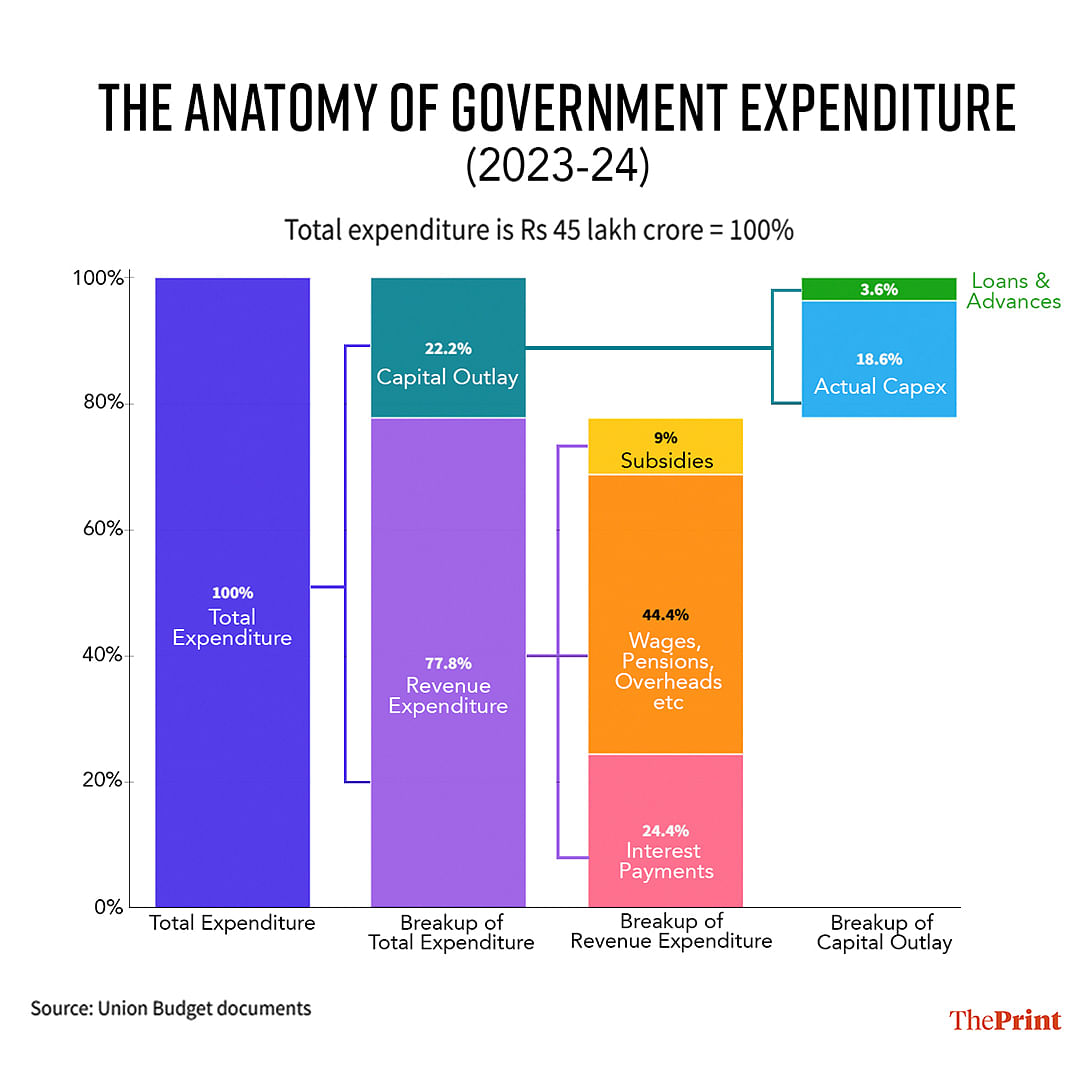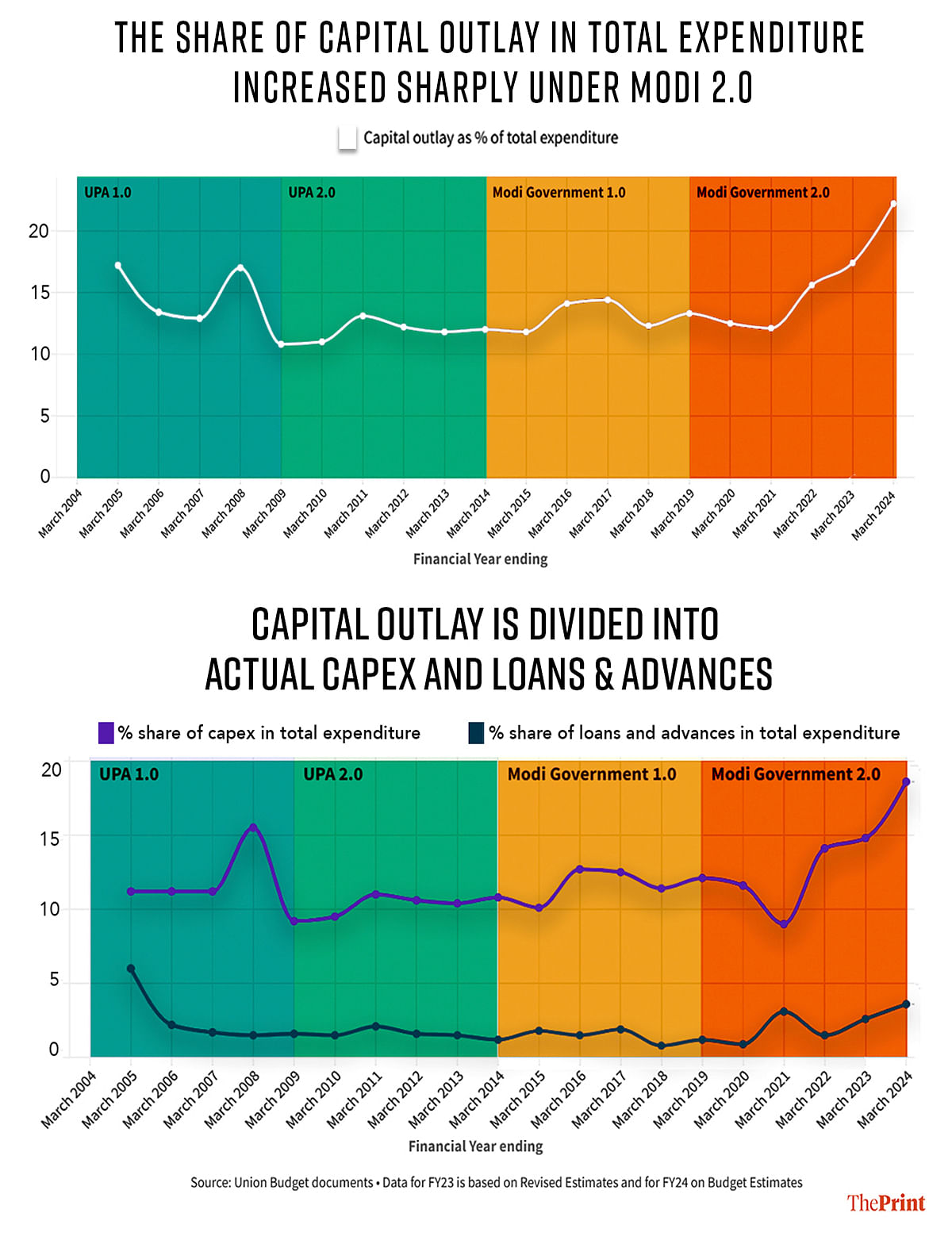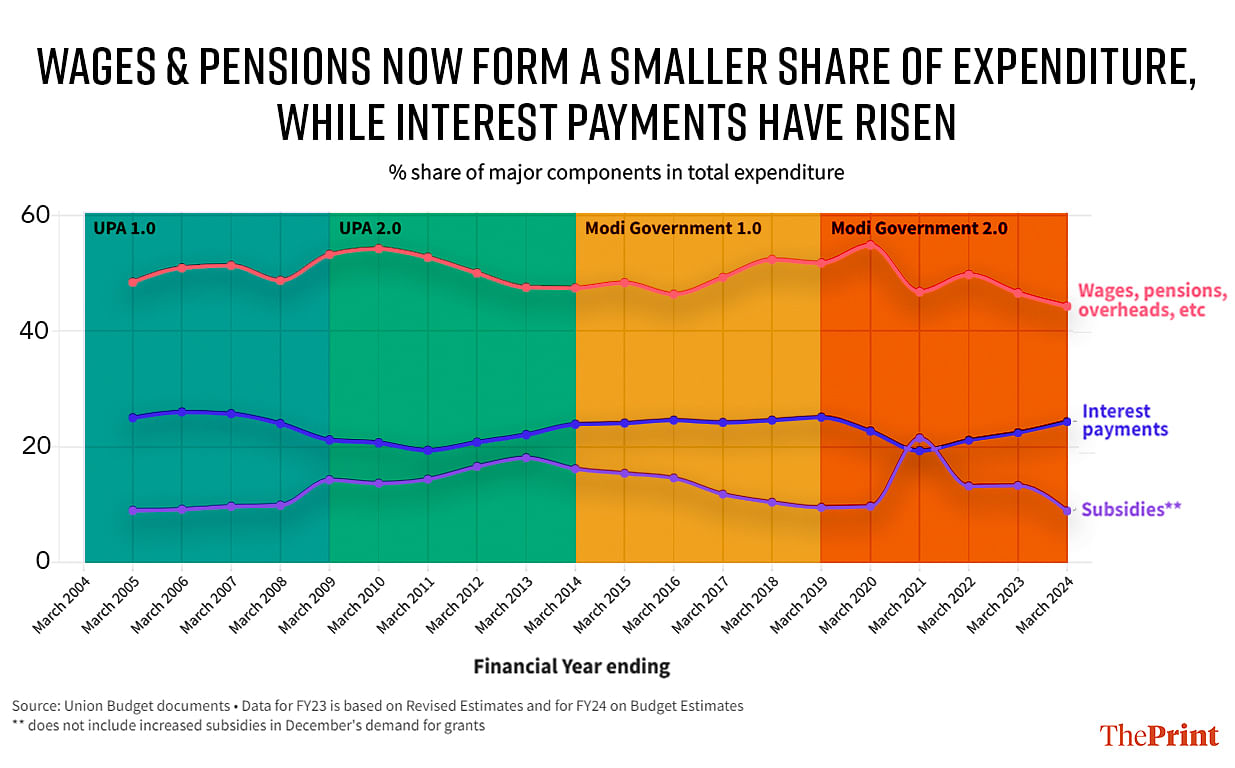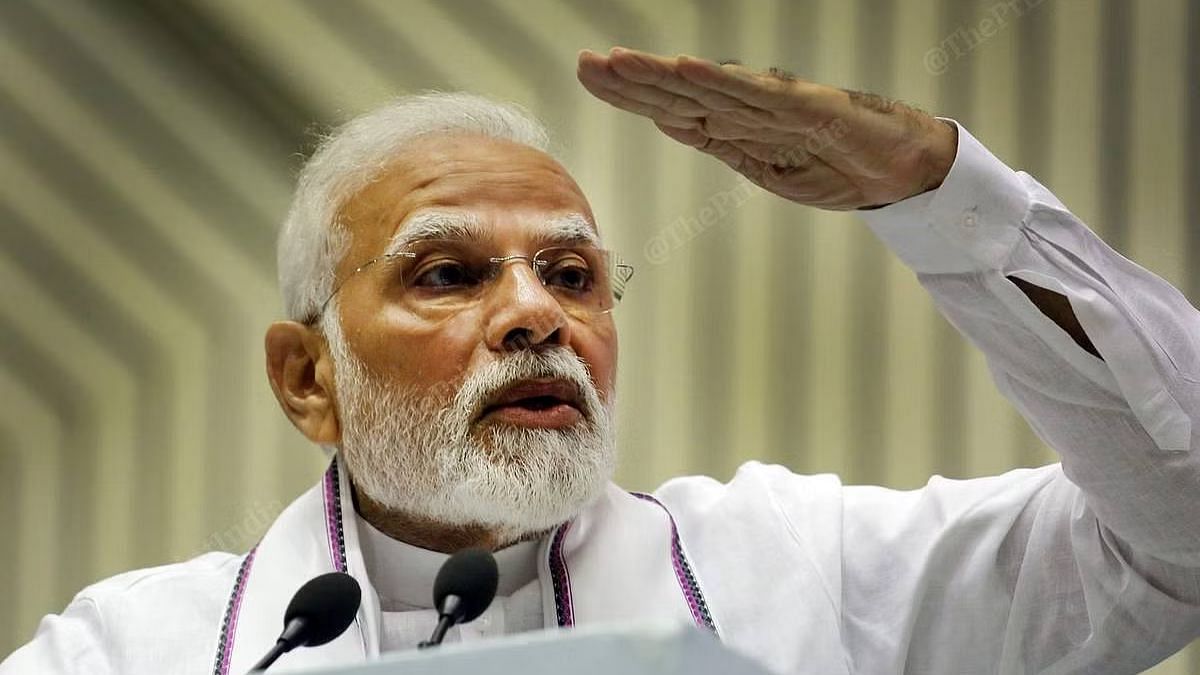New Delhi: The Modi government’s focus on capital investments and reducing wasteful expenditure hasn’t been restricted to mere rhetoric, an analysis of budget data from the past 20 years shows. During the 10 years of the Narendra Modi government at the Centre, the share of actual capital expenditure in total government spending has risen to historic highs, while the share of subsidies has fallen sharply to decadal lows.
In contrast, the same data for the Congress-led United Progressive Alliance’s (UPA’s 10 years shows that the share of capital expenditure fell over this period, while the share of subsidies nearly doubled, revealing the differing spending priorities of the two governments.
An in-depth analysis by ThePrint of Union Budget documents over the period 2004-24 shows that the government’s actual capital expenditure will be 18.6 percent of its total expenditure for the financial year 2023-24, according to the latest budget. This is the highest it has been in the past 20 years, and continues a rising trend seen since the pandemic year of 2020-21.
At the same time, subsidies have been forming a lower share of total expenditure over the course of the Modi government’s term since 2014-15, except for a pandemic-induced spike in 2020-21. Since then, the declining trend has returned, with the share of subsidies in total government spending falling.
It is important to note that the figures for 2023-24 do not include the Rs 28,630.80 crore of additional subsidy spending the government sought approval for in the supplementary demand for grants it presented to Parliament earlier this month.
However, calculations show that this additional spending would amount to just an added 0.5 percent of total government expenditure.
Also read: Budget 2023: Modi govt on track on 2022 capex promises, states lag. Punjab, Bihar repeat offenders
How do governments spend their money?
Before delving into the 20-year trend of government spending, it is important to first understand how government spending is done. That is, the various broad heads under which spending is categorised.

The first level of division in government spending is between the oxymoronically named revenue expenditure and capital outlay. Revenue expenditure is the spending the government does on the ‘revenue’ account, which basically involves the spending done for the normal functioning of government departments. Revenue expenditure forms the bulk of government spending, budgeted to form nearly 78 percent of total government spending in 2023-24.
Revenue expenditure can broadly be divided into three categories — interest payments on loans taken by the government, subsidies, and the third, largest category of salaries, pensions, and overheads.
In 2023-24, interest payments are budgeted to form nearly one-fourth of all government spending, subsidies are expected to form nine percent, and salaries, pensions and overheads comprise nearly 45 percent.
Capital outlay is broadly the spending the government does on the creation or acquisition of fixed assets like buildings, roads, bridges, etc. This broad category is budgeted to make up a little more than 22 percent of the total expenditure of the government in 2023-24.
Capital outlay is broken up into actual capital expenditure (capex) done by the government and the loans and advances it gives to state governments, public sector enterprises, and foreign governments. The actual capex of the government makes up about 19 percent of the government’s total spending, and loans and advances form about four percent.
Modi government’s increased focus on capex
The 22.2 percent share of capital outlay in total expenditure in 2023-24 is the highest in the past 20 years by a long way. The Modi government ended its first year in power (2014-15) with capital outlay forming 11.8 percent of total expenditure. By the end of its first term (2018-19), this increased only marginally to 13.3 percent.

It was in the Modi government’s second term — notably since the pandemic — that the share of capital outlay really shot up.
This is in contrast to what happened during the UPA decade. The UPA ended its first year in power (2004-05) with capital outlay forming 17.2 percent of total spending. This fell to 10.8 percent by 2008-09, the end of its first term. By the time it ended its second term in 2013-14, this rose only marginally to 12 percent.
The rapid increase in the share of capital outlay during the period of the Modi government was propelled by an increase in the shares of both its sub-categories—actual capex and loans and advances.
Actual capex as a share of total expenditure fell from 11.2 percent in 2004-05 to 9.2 percent in 2008-09 and rose again to 10.8 percent by 2013-14. Thereafter, it rose to 12.1 percent by 2018-19 and further to a significant 18.6 percent by 2023-24.
The UPA period saw a steady fall in the share of loans and advances in total expenditure, from six percent in 2004-05 to 1.6 percent in 2008-09 and 1.2 percent in 2013-14. It remained at the same level by the end of the Modi government’s first term.
Notably, loans and advances given by the government — which often don’t add to economic growth and do so indirectly and with lagged effect when they do — have been forming an increasing share of the government’s expenditure since the pandemic, rising to 3.6 percent in 2023-24.
Rising interest burden, falling share of subsidies
The share of interest payments — which impose a burden on government finances as they are an additional cost — has moved between a narrow band over the past 20 years. However, a look at the movement during each term of government lends some insight into how burdened each government has been.

Graphic: Soham Sen | ThePrintThe share of interest payments fell during the first term of the UPA, but then rose again in the second term. It then continued to rise during the course of the first term of the Modi government, before starting to decline until the pandemic hit. Thereafter, the share of interest payments has risen again at an even and brisk pace — from 19.4 percent as of March 2021 to 24.4 percent by March 2024.
This is likely on account of the increased borrowing the government had to undertake during the pandemic period to tide over the sudden lockdown-induced increase in expenditure and fall in revenue.
The trajectory of the share of subsidies in total expenditure yields a much more stark insight into the priorities of the UPA and the Modi government. This share increased from about nine percent in 2004-05 to 14.4 percent in 2008-09, and further to 16.3 percent by 2013-14.
In contrast, under the Modi government, the share of subsidies has been falling, apart from during the pandemic-affected years. By the completion of its first year, it had fallen to 15.3 percent, which fell steadily during the first term to 9.6 percent in 2018-19. It spiked from there to nearly 22 percent during 2020-21, the pandemic year, before again falling quickly to nine percent in 2023-24.
The government has indeed sought and received permission from Parliament to spend an additional Rs 28,630.80 crore on food, LPG, and fertiliser subsidies. However, even after adding this, the subsidy expenditure would be 9.5 percent of total expenditure, which is the lowest it has been since 2005-06.
(Edited by Poulomi Banerjee)
Also read: States spending better, with many prioritising capex. But those dependent on Centre may face stress

